ZHCSAK5C December 2012 – December 2015 ADS42B49
PRODUCTION DATA.
- 1 特性
- 2 应用
- 3 说明
- 4 修订历史记录
- 5 Description (continued)
- 6 ADS424x and ADS422x Family Comparison
- 7 Pin Configuration and Functions
-
8 Specifications
- 8.1 Absolute Maximum Ratings
- 8.2 ESD Ratings
- 8.3 Recommended Operating Conditions
- 8.4 Thermal Information
- 8.5 Electrical Characteristics: ADS42B49 (250 MSPS)
- 8.6 Electrical Characteristics: General
- 8.7 Digital Characteristics
- 8.8 Timing Requirements: LVDS and CMOS Modes
- 8.9 Serial Interface Timing Characteristics
- 8.10 Reset Timing (Only When Serial Interface is Used)
- 8.11 LVDS Timings at Lower Sampling Frequencies
- 8.12 CMOS Timings at Lower Sampling Frequencies
- 8.13 Typical Characteristics
- 9 Parameter Measurement Information
- 10Detailed Description
- 11Application and Implementation
- 12Power Supply Recommendations
- 13Layout
- 14器件和文档支持
- 15机械、封装和可订购信息
8 Specifications
8.1 Absolute Maximum Ratings
over operating free-air temperature range (unless otherwise noted)(1)| MIN | MAX | UNIT | ||
|---|---|---|---|---|
| Supply voltage | AVDD | –0.3 | 2.1 | V |
| AVDD_BUF | –0.3 | 3.6 | V | |
| DRVDD | –0.3 | 2.1 | V | |
| Voltage between: | AGND and DRGND | –0.3 | 0.3 | V |
| AVDD to DRVDD (when AVDD leads DRVDD) |
–2.4 | 2.4 | V | |
| DRVDD to AVDD (when DRVDD leads AVDD) |
–2.4 | 2.4 | V | |
| AVDD_BUF to DRVDD and AVDD | –3.9 | 3.9 | V | |
| Voltage applied to | INP, INM | –0.3 | Minimum (3, AVDD_BUF + 0.3) |
V |
| CLKP, CLKM(2) | –0.3 | AVDD + 0.3 | V | |
| RESET, SCLK, SDATA, SEN, CTRL1, CTRL2, CTRL3 |
–0.3 | 3.9 | V | |
| Temperature | Operating free-air, TA | –40 | 85 | °C |
| Operating junction, TJ | 125 | °C | ||
| Storage, Tstg | –65 | 150 | °C | |
(1) Stresses beyond those listed under Absolute Maximum Ratings may cause permanent damage to the device. These are stress ratings only, which do not imply functional operation of the device at these or any other conditions beyond those indicated under Recommended Operating Conditions. Exposure to absolute-maximum-rated conditions for extended periods may affect device reliability.
(2) When AVDD is turned off, TI recommends switching off the input clock (or ensuring the voltage on CLKP, CLKM is less than |0.3 V|). This configuration prevents the ESD protection diodes at the clock input pins from turning on.
8.2 ESD Ratings
| VALUE | UNIT | |||
|---|---|---|---|---|
| V(ESD) | Electrostatic discharge | Human-body model (HBM), per ANSI/ESDA/JEDEC JS-001(1) | ±2000 | V |
| Charged-device model (CDM), per JEDEC specification JESD22-C101(2) | ±500 | |||
(1) JEDEC document JEP155 states that 500-V HBM allows safe manufacturing with a standard ESD control process.
(2) JEDEC document JEP157 states that 250-V CDM allows safe manufacturing with a standard ESD control process.
8.3 Recommended Operating Conditions
over operating free-air temperature range, unless otherwise noted.| PARAMETER | MIN | NOM | MAX | UNIT | ||
|---|---|---|---|---|---|---|
| SUPPLIES | ||||||
| AVDD | Analog supply voltage | 1.8 | 1.9 | 2 | V | |
| AVDD_BUF | Analog buffer supply voltage | 3.15 | 3.3 | 3.45 | V | |
| DRVDD | Digital supply voltage | 1.7 | 1.8 | 2 | V | |
| ANALOG INPUTS | ||||||
| VID | Differential input voltage range | 2 | VPP | |||
| VICR | Input common-mode voltage | VCM ± 0.05 | V | |||
| Maximum analog input frequency with 2-VPP input amplitude(1) | 400 | MHz | ||||
| Maximum analog input frequency with 1.6-VPP input amplitude(1) | 500 | MHz | ||||
| CLOCK INPUT | ||||||
| Input clock sample rate | Low-speed mode enabled(2) | 1 | 80 | MSPS | ||
| Low-speed mode disabled(2) (by default after reset) | 80 | 250 | MSPS | |||
| Input clock amplitude differential (VCLKP – VCLKM) |
Sine wave, ac-coupled | 0.2 | 1.5 | VPP | ||
| LVPECL, ac-coupled | 1.6 | VPP | ||||
| LVDS, ac-coupled | 0.7 | VPP | ||||
| LVCMOS, single-ended, ac-coupled | 1.5 | V | ||||
| Input clock duty cycle | Low-speed mode disabled | 45% | 50% | 55% | ||
| Low-speed mode enabled | 40% | 50% | 60% | |||
| DIGITAL OUTPUTS | ||||||
| CLOAD | Maximum external load capacitance from each output pin to DRGND | 3.3 | pF | |||
| RLOAD | Differential load resistance between the LVDS output pairs (LVDS mode) | 100 | Ω | |||
| TA | Operating free-air temperature | –40 | 85 | °C | ||
(1) See the Analog Input section in the Application Information.
(2) See the Serial Interface Configuration section for details on programming the low-speed mode.
8.4 Thermal Information
| THERMAL METRIC(1) | ADS42B49 | UNIT | |
|---|---|---|---|
| RGC (VQFN) | |||
| 64 PINS | |||
| RθJA | Junction-to-ambient thermal resistance | 23.9 | °C/W |
| RθJC(top) | Junction-to-case (top) thermal resistance | 10.9 | °C/W |
| RθJB | Junction-to-board thermal resistance | 4.3 | °C/W |
| ψJT | Junction-to-top characterization parameter | 0.1 | °C/W |
| ψJB | Junction-to-board characterization parameter | 4.4 | °C/W |
| RθJC(bot) | Junction-to-case (bottom) thermal resistance | 0.6 | °C/W |
(1) For more information about traditional and new thermal metrics, see the Semiconductor and IC Package Thermal Metrics application report, SPRA953.
8.5 Electrical Characteristics: ADS42B49 (250 MSPS)
Typical values are at 25°C, AVDD = 1.9 V, AVDD_BUF = 3.3 V, DRVDD = 1.8 V, 50% clock duty cycle, –1-dBFS differential analog input, LVDS interface, and 0-dB gain, unless otherwise noted. Minimum and maximum values are across the full temperature range: TMIN = –40°C to TMAX = 85°C, AVDD = 1.9 V, AVDD_BUF = 3.3 V, and DRVDD = 1.8 V.8.6 Electrical Characteristics: General
Typical values are at 25°C, AVDD = 1.9 V, AVDD_BUF = 3.3 V, DRVDD = 1.8 V, 50% clock duty cycle, and –1-dBFS differential analog input, unless otherwise noted. Minimum and maximum values are across the full temperature range: TMIN = –40°C to TMAX = 85°C, AVDD = 1.9 V, AVDD_BUF = 3.3 V, and DRVDD = 1.8 V.| PARAMETER | MIN | TYP | MAX | UNIT | ||
|---|---|---|---|---|---|---|
| ANALOG INPUTS | ||||||
| VID | Differential input voltage range | 2 | VPP | |||
| Differential input resistance (at 170 MHz) | 1.2 | kΩ | ||||
| Differential input capacitance (at 170 MHz) | 2.2 | pF | ||||
| Analog input bandwidth (with 50-Ω source impedance, and 50-Ω termination) |
700 | MHz | ||||
| VCM | Common-mode output voltage | 1.9(2) | V | |||
| VCM output current capability | 10 | mA | ||||
| DC ACCURACY | ||||||
| Offset error | –20 | 3 | 20 | mV | ||
| EGREF | Gain error as a result of internal reference inaccuracy alone | –2 | 2 | %FS | ||
| EGCHAN | Gain error of channel alone | –5 | %FS | |||
| Temperature coefficient of EGCHAN | 0.005 | Δ%/°C | ||||
| POWER SUPPLY | ||||||
| IAVDD | Analog supply current | 186 | 225 | mA | ||
| IAVDD_BUF | Analog buffer supply current | 67 | 90 | mA | ||
| IDRVDD | Output buffer supply current | LVDS interface, 350-mV swing with 100-Ω external termination, fIN = 2.5 MHz | 151 | 180 | mA | |
| CMOS interface, 8-pF external load capacitance, fIN = 2.5 MHz(1) |
128 | mA | ||||
| Analog power | 353 | mW | ||||
| Analog buffer power | 224 | mW | ||||
| Digital power, LVDS interface, 350-mV swing with 100-Ω external termination, fIN = 2.5 MHz | 272 | mW | ||||
| Digital power, CMOS interface, 8-pF external load capacitance,(1) fIN = 2.5 MHz | 230 | mW | ||||
| Total power, LVDS interface, 350-mV swing with 100-Ω external termination, fIN = 2.5 MHz | 850 | 925 | mW | |||
| Global power-down | 20 | mW | ||||
(1) In CMOS mode, the DRVDD current scales with the sampling frequency, the load capacitance on output pins, input frequency, and the supply voltage (see the CMOS Interface Power Dissipation section in the Application Information).
(2) After the HIGH PERF MODE[10:0] bits are set.
8.7 Digital Characteristics
At AVDD = 1.9 V, AVDD_BUF = 3.3 V, and DRVDD = 1.8 V, unless otherwise noted. DC specifications refer to the condition where the digital outputs do not switch, but are permanently at a valid logic level 0 or 1.| PARAMETER | TEST CONDITIONS | MIN | TYP | MAX | UNIT | ||
|---|---|---|---|---|---|---|---|
| DIGITAL INPUTS (RESET, SCLK, SDATA, SEN, CTRL1, CTRL2, CTRL3)(1) | |||||||
| VIH | High-level input voltage | All digital inputs support 1.8-V and 3.3-V CMOS logic levels | 1.3 | V | |||
| VIL | Low-level input voltage | 0.4 | V | ||||
| IIH | High-level input current | SDATA, SCLK(2) | VHIGH = 1.8 V | 10 | µA | ||
| SEN(3) | VHIGH = 1.8 V | 0 | |||||
| IIL | Low-level input current | SDATA, SCLK | VLOW = 0 V | 0 | µA | ||
| SEN | VLOW = 0 V | 10 | |||||
| DIGITAL OUTPUTS, CMOS INTERFACE (DA[13:0], DB[13:0], CLKOUT, SDOUT) | |||||||
| VOH | High-level output voltage | DRVDD – 0.1 | DRVDD | V | |||
| VOL | Low-level output voltage | 0 | 0.1 | V | |||
| CO | Output capacitance (internal to device) | pF | |||||
| DIGITAL OUTPUTS, LVDS INTERFACE | |||||||
| VODH | High-level output differential voltage | With an external 100-Ω termination |
275 | 350 | 425 | mV | |
| VODL | Low-level output differential voltage | With an external 100-Ω termination |
–425 | –350 | –275 | mV | |
| VOCM | Output common-mode voltage | 0.9 | 1.05 | 1.25 | V | ||
(1) SCLK, SDATA, and SEN function as digital input pins in serial configuration mode.
(2) SDATA and SCLK have an internal 150-kΩ pull-down resistor.
(3) SEN has an internal 150-kΩ pull-up resistor to AVDD. Because the pull-up resistor is weak, SEN can also be driven by 1.8-V or 3.3-V CMOS buffers.
8.8 Timing Requirements: LVDS and CMOS Modes
Typical values are at 25°C, AVDD = 1.9 V, AVDD_BUF = 3.3 V, DRVDD = 1.8 V, sampling frequency = 250 MSPS, sine wave input clock, CLOAD = 3.3 pF, and RLOAD = 100 Ω, unless otherwise noted. Minimum and maximum values are across the full temperature range: TMIN = –40°C to TMAX = 85°C, AVDD = 1.9 V, AVDD_BUF = 3.3 V, and DRVDD = 1.7 V to 2 V.| MIN | NOM | MAX | UNIT | |||
|---|---|---|---|---|---|---|
| tA | Aperture delay | 0.5 | 0.8 | 1.1 | ns | |
| Aperture delay matching | Between two channels of the same device | ±70 | ps | |||
| Variation of aperture delay | Between two devices at the same temperature and DRVDD supply | ±150 | ps | |||
| tJ | Aperture jitter | 120 | fS rms | |||
| Wakeup time | Time to valid data after coming out of STANDBY mode | 50 | µs | |||
| Time to valid data after coming out of GLOBAL power-down mode | 100 | µs | ||||
| ADC latency(4) | Default latency after reset | 11 | Clock cycles | |||
| Digital functions enabled (EN DIGITAL = 1) | 19 | Clock cycles | ||||
| DDR LVDS MODE(1)(2) | ||||||
| tSU_RISE | Data setup time on rising edge of CLKOUTP | Data valid to zero-crossing of differential output clock (CLKOUTP – CLKOUTM)(3) | 0.32 | 0.68 | ns | |
| tHO_RISE | Data hold time on rising edge of CLKOUTP | Zero-crossing of differential output clock (CLKOUTP – CLKOUTM) to data becoming invalid(3) | 0.5 | 0.82 | ns | |
| tSU_FALL | Data setup time on falling edge of CLKOUTP | Data valid to zero-crossing of differential output clock (CLKOUTP – CLKOUTM)(3) | 0.63 | 1.04 | ns | |
| tHO_FALL | Data hold time on falling edge of CLKOUTP | Zero-crossing of differential output clock (CLKOUTP – CLKOUTM) to data becoming invalid(3) | 0.18 | 0.58 | ns | |
| tPDI | Clock propagation delay | Input clock rising edge cross-over to output clock (CLKOUTP – CLKOUTM) rising edge cross-over | 7.6 | 8.9 | 10.2 | ns |
| LVDS bit clock duty cycle | Duty cycle of differential clock (CLKOUTP – CLKOUTM) |
57% | ||||
| tFALL, tRISE |
Data fall time, Data rise time |
Rise time measured from –100 mV to 100 mV 1 MSPS ≤ Sampling frequency ≤ 250 MSPS |
0.13 | ns | ||
| tCLKRISE, tCLKFALL |
Output clock rise time, Output clock fall time |
Rise time measured from –100 mV to 100 mV 1 MSPS ≤ Sampling frequency ≤ 250 MSPS |
0.13 | ns | ||
| tRISE, tFALL |
Data rise time, Data fall time |
Rise time measured from 20% to 80% of DRVDD 1 MSPS ≤ Sampling frequency ≤ 250 MSPS |
0.13 | ns | ||
| tCLKRISE, tCLKFALL |
Output clock rise time, Output clock fall time |
Rise time measured from 20% to 80% of DRVDD 1 MSPS ≤ Sampling frequency ≤ 250 MSPS |
0.13 | ns | ||
| PARALLEL CMOS MODE | ||||||
| tPDI | Clock propagation delay | Input clock rising edge cross-over to output clock rising edge cross-over | 5.9 | 8.3 | 10.6 | ns |
| Output clock duty cycle | Duty cycle of output clock, CLKOUT 1 MSPS ≤ Sampling frequency ≤ 200 MSPS |
50% | ||||
| tRISE, tFALL |
Data rise time, Data fall time |
Rise time measured from 20% to 80% of DRVDD Fall time measured from 80% to 20% of DRVDD 1 MSPS ≤ Sampling frequency ≤ 200 MSPS |
0.7 | ns | ||
| tCLKRISE, tCLKFALL |
Output clock rise time Output clock fall time |
Rise time measured from 20% to 80% of DRVDD Fall time measured from 80% to 20% of DRVDD 1 MSPS ≤ Sampling frequency ≤ 200 MSPS |
0.7 | ns | ||
(1) Setup and hold values in DDR LVDS mode are taken with a delayed output clock by writing register 42h, value 30h.
(2) Measurements are done with a transmission line of a 100-Ω characteristic impedance between the device and load. Setup and hold time specifications take into account the effect of jitter on the output data and clock.
(3) Data valid refers to a logic high of 100 mV and a logic low of –100 mV.
(4) Overall latency = ADC latency + tPDI. At 250 MSPS, tPDI is greater than two clock periods. Therefore, overall latency at 250 MSPS = ADC latency + 2 clock cycles.
8.9 Serial Interface Timing Characteristics
Typical values at 25°C; minimum and maximum values across the full temperature range: TMIN = –40°C to TMAX = 85°C, AVDD = 1.9 V, AVDD_BUF = 3.3 V, and DRVDD = 1.8 V, unless otherwise noted.| MIN | NOM | MAX | UNIT | ||
|---|---|---|---|---|---|
| fSCLK | SCLK frequency (equal to 1 / tSCLK) | > dc | 20 | MHz | |
| tSLOADS | SEN to SCLK setup time | 25 | ns | ||
| tSLOADH | SCLK to SEN hold time | 25 | ns | ||
| tDSU | SDATA setup time | 25 | ns | ||
| tDH | SDATA hold time | 25 | ns | ||
8.10 Reset Timing (Only When Serial Interface is Used)
Typical values at 25°C; minimum and maximum values across the full temperature range: TMIN = –40°C to TMAX = 85°C, unless otherwise noted.| MIN | NOM | MAX | UNIT | |||
|---|---|---|---|---|---|---|
| t1 | Power-on delay | Delay from AVDD and DRVDD power-up to active RESET pulse | 1 | ms | ||
| t2 | Reset pulse width | Active RESET signal pulse width | 10 | ns | ||
| 1 | µs | |||||
| t3 | Register write delay | Delay from RESET disable to SEN active | 100 | ns | ||
8.11 LVDS Timings at Lower Sampling Frequencies(1)
| SAMPLING FREQUENCY (MSPS) | SETUP TIME (ns) | HOLD TIME (ns) | CLOCK PROPAGATION DELAY (ns) |
||||||||||||
|---|---|---|---|---|---|---|---|---|---|---|---|---|---|---|---|
| tSU_RISE | tSU_FALL | tHO_RISE | tHO_FALL | tPDI | |||||||||||
| MIN | TYP | MAX | MIN | TYP | MAX | MIN | TYP | MAX | MIN | TYP | MAX | MIN | TYP | MAX | |
| 100 | 0.36 | 0.72 | 0.67 | 1.10 | 3.37 | 3.80 | 3.02 | 3.48 | 10.4 | 11.8 | 13.1 | ||||
| 125 | 0.35 | 0.72 | 0.66 | 1.08 | 2.43 | 2.82 | 2.09 | 2.51 | 9.4 | 10.8 | 12.1 | ||||
| 150 | 0.35 | 0.70 | 0.66 | 1.07 | 1.77 | 2.15 | 1.47 | 1.86 | 8.8 | 10.1 | 11.5 | ||||
| 175 | 0.35 | 0.70 | 0.63 | 1.07 | 1.32 | 1.67 | 1.00 | 1.40 | 8.3 | 9.7 | 11.0 | ||||
| 200 | 0.38 | 0.70 | 0.68 | 1.08 | 0.93 | 1.29 | 0.66 | 1.04 | 8.0 | 9.4 | 10.8 | ||||
| 230 | 0.33 | 0.69 | 0.67 | 1.06 | 0.63 | 0.97 | 0.35 | 0.74 | 7.7 | 9.1 | 10.5 | ||||
(1) Setup and hold values in DDR LVDS mode belong to delayed output clock by writing register 42h, value 30h.
8.12 CMOS Timings at Lower Sampling Frequencies
| SAMPLING FREQUENCY (MSPS) | SETUP TIME(1)
(tSU, ns) |
HOLD TIME(1)
(tHO, ns) |
CLOCK PROPAGATION DELAY (tPDI, ns) |
||||||
|---|---|---|---|---|---|---|---|---|---|
| MIN | TYP | MAX | MIN | TYP | MAX | MIN | TYP | MAX | |
| 100 | 3.91 | 4.40 | 3.68 | 4.18 | 9.5 | 11.5 | 13.3 | ||
| 125 | 2.81 | 3.40 | 2.73 | 3.14 | 8.5 | 10.5 | 12.3 | ||
| 150 | 2.00 | 2.64 | 2.09 | 2.52 | 7.9 | 9.9 | 11.7 | ||
| 175 | 1.43 | 2.14 | 1.67 | 2.06 | 7.6 | 9.4 | 11.4 | ||
| 200 | 1.01 | 1.76 | 1.25 | 1.68 | 6.4 | 8.9 | 11.1 | ||
(1) In CMOS mode, setup time is measured from the beginning of data valid to the mid-point of the CLKOUT rising edge, whereas hold time is measured from the mid-point of the CLKOUT rising edge to data becoming invalid.
8.13 Typical Characteristics
8.13.1 ADS42B49
At TA = 25°C, AVDD = 1.9 V, AVDD_BUF = 3.3 V, DRVDD = 1.8 V, maximum rated sampling frequency, sine wave input clock, 1.5-VPP differential clock amplitude, 50% clock duty cycle, –1-dBFS differential analog input, high-performance mode disabled, 0-dB gain, DDR LVDS output interface, and 32k-point FFT, unless otherwise noted.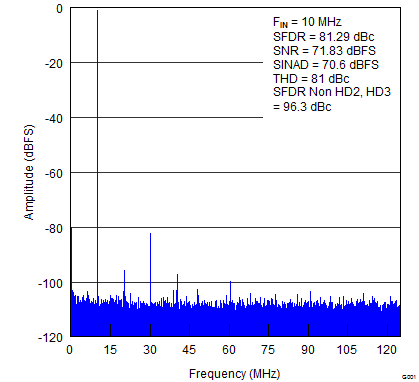 Figure 1. Input Signal (10 MHz)
Figure 1. Input Signal (10 MHz)
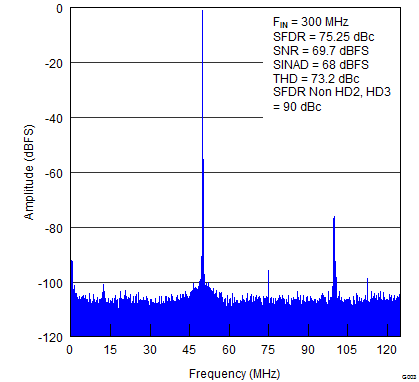 Figure 3. Input Signal (300 MHz)
Figure 3. Input Signal (300 MHz)
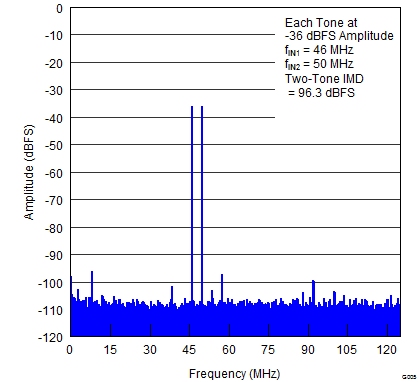 Figure 5. Two-Tone Input Signal
Figure 5. Two-Tone Input Signal
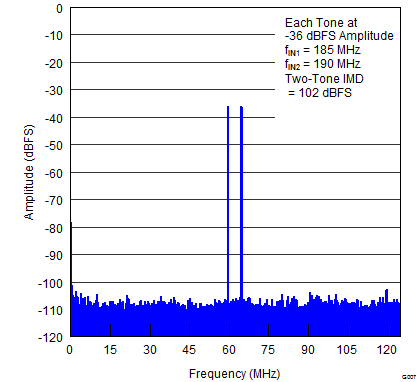 Figure 7. Two-Tone Input Signal
Figure 7. Two-Tone Input Signal
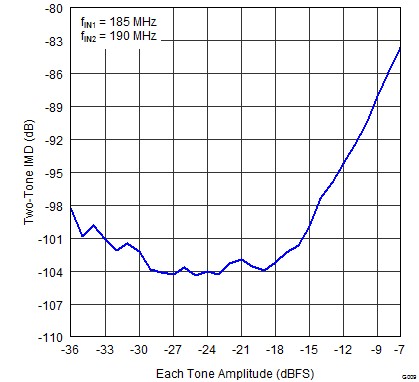 Figure 9. Two-Tone IMD3 vs Input Amplitude
Figure 9. Two-Tone IMD3 vs Input Amplitude
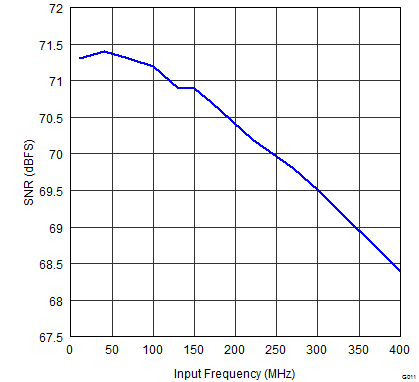 Figure 11. Signal-to-Noise Ratio vs Input Frequency
Figure 11. Signal-to-Noise Ratio vs Input Frequency
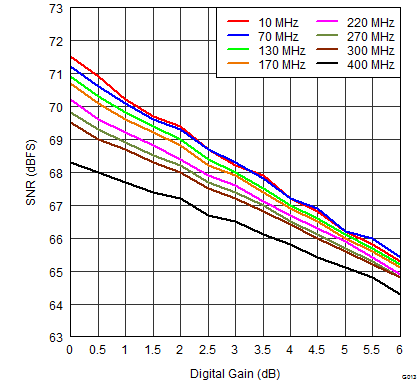 Figure 13. Signal-to-Noise Ratio
Figure 13. Signal-to-Noise Ratio vs Gain and Input Frequency
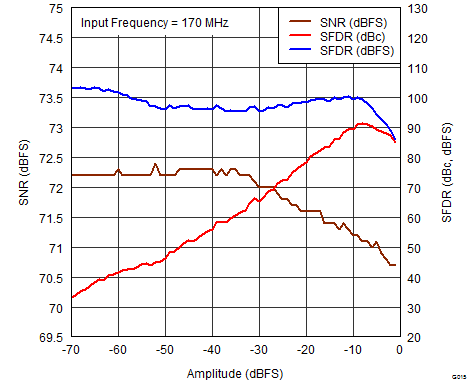 Figure 15. Performance vs Input Amplitude
Figure 15. Performance vs Input Amplitude
 Figure 17. Performance
Figure 17. Performance vs Input Common-Mode Voltage
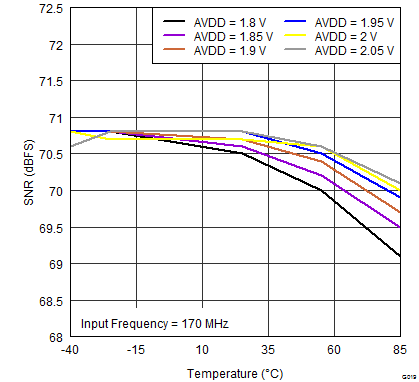 Figure 19. Signal-to-Noise Ratio
Figure 19. Signal-to-Noise Ratio vs Temperature and AVDD Supply
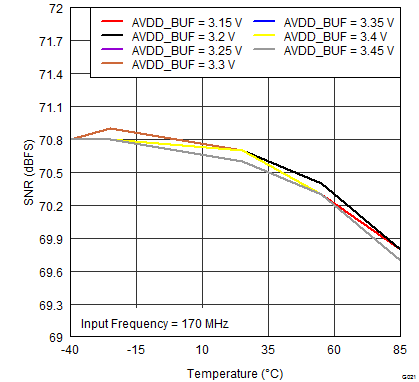 Figure 21. Signal-to-Noise Ratio
Figure 21. Signal-to-Noise Ratio vs Temperature and AVDD_BUF Supply
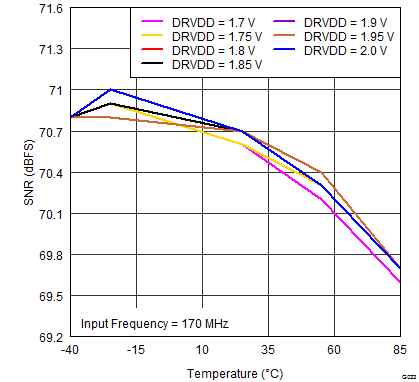 Figure 23. Signal-to-Noise Ratio
Figure 23. Signal-to-Noise Ratio vs Temperature and DRVDD Supply Voltage
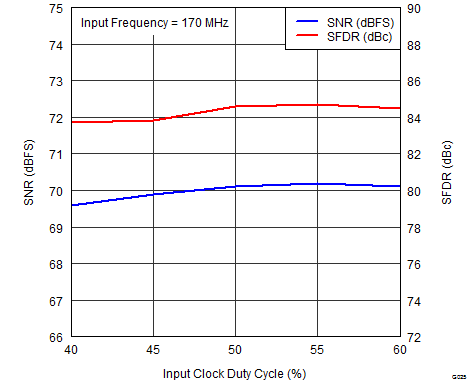 Figure 25. Performance vs Input Clock Duty Cycle
Figure 25. Performance vs Input Clock Duty Cycle
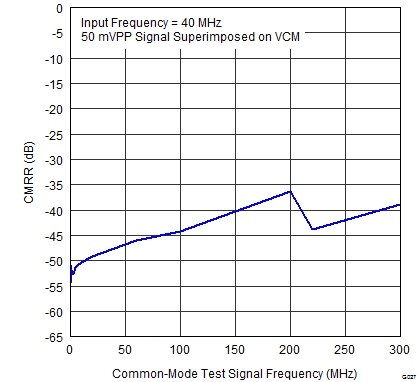 Figure 27. Common-Mode Rejection Ratio
Figure 27. Common-Mode Rejection Ratio vs Test Signal Frequency
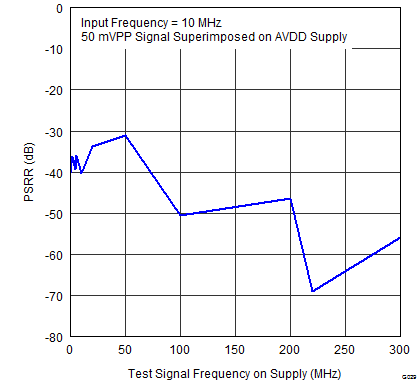 Figure 29. Power-Supply Rejection Ratio
Figure 29. Power-Supply Rejection Ratio vs Test Signal Frequency
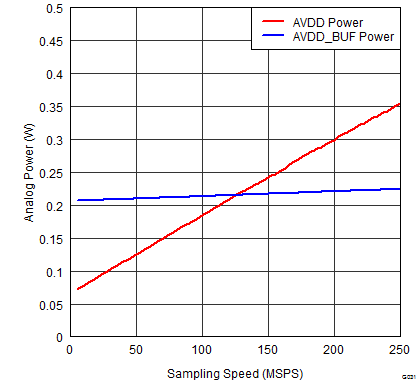 Figure 31. Analog Power vs Sampling Frequency
Figure 31. Analog Power vs Sampling Frequency
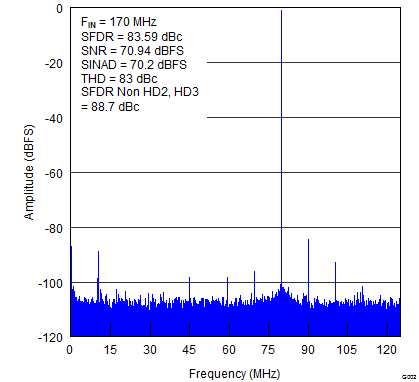 Figure 2. Input Signal (170 MHz)
Figure 2. Input Signal (170 MHz)
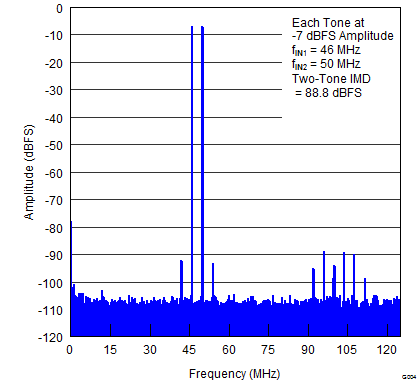 Figure 4. Two-Tone Input Signal
Figure 4. Two-Tone Input Signal
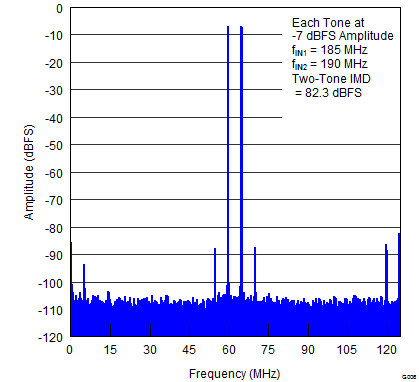 Figure 6. Two-Tone Input Signal
Figure 6. Two-Tone Input Signal
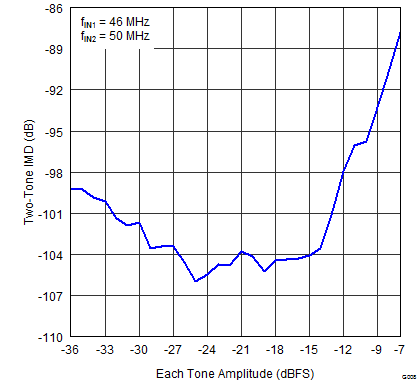 Figure 8. Two-Tone IMD3 vs Input Amplitude
Figure 8. Two-Tone IMD3 vs Input Amplitude
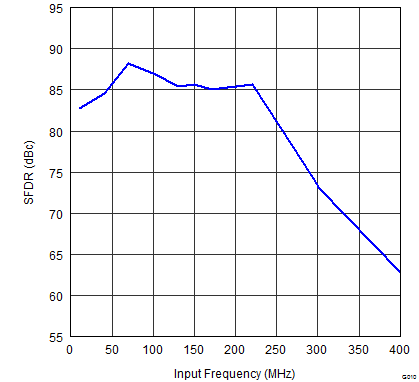 Figure 10. Spurious-Free Dynamic Range
Figure 10. Spurious-Free Dynamic Range vs Input Frequency
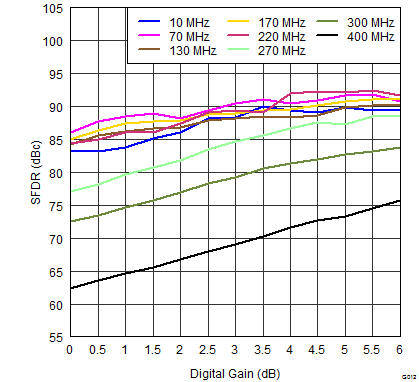 Figure 12. Spurious-Free Dynamic Range
Figure 12. Spurious-Free Dynamic Range vs Gain and Input Frequency
Figure 14. Performance vs Input Amplitude
 Figure 16. Performance
Figure 16. Performance vs Input Common-Mode Voltage
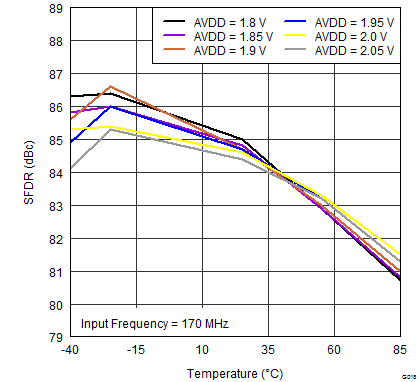 Figure 18. Spurious-Free Dynamic Range
Figure 18. Spurious-Free Dynamic Range vs Temperature and AVDD Supply
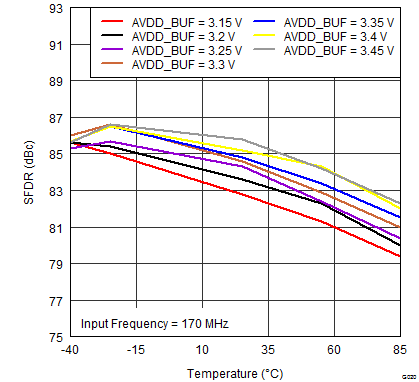 Figure 20. Spurious-Free Dynamic Range
Figure 20. Spurious-Free Dynamic Range vs Temperature and AVDD_BUF Supply
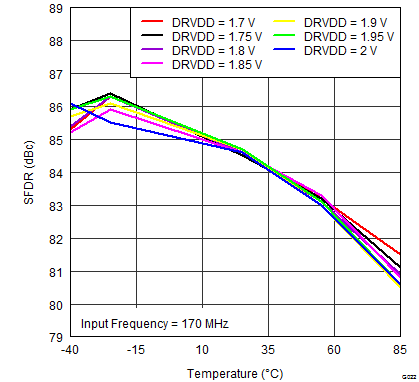 Figure 22. Spurious-Free Dynamic Range
Figure 22. Spurious-Free Dynamic Range vs Temperature and DRVDD Supply Voltage
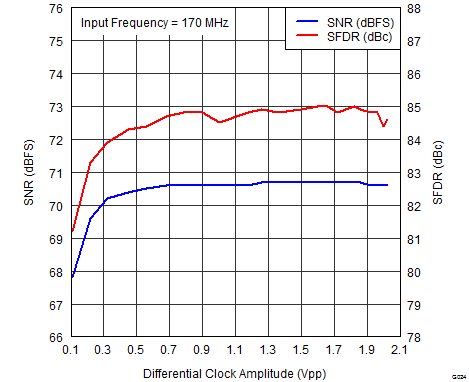 Figure 24. Performance vs Input Clock Amplitude
Figure 24. Performance vs Input Clock Amplitude
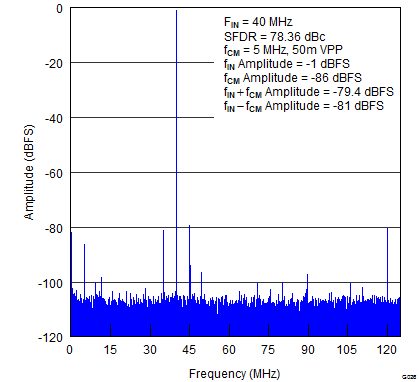 Figure 26. Common-Mode Rejection Ratio Plot
Figure 26. Common-Mode Rejection Ratio Plot
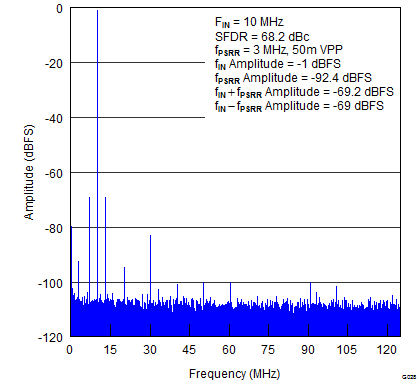 Figure 28. Power-Supply Rejection Ratio Plot
Figure 28. Power-Supply Rejection Ratio Plot
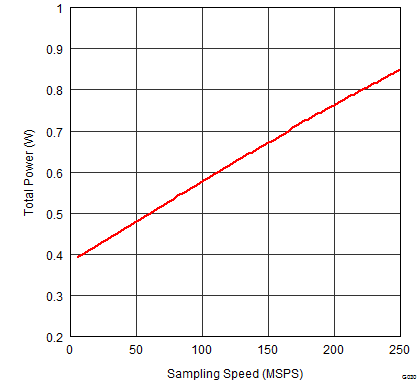 Figure 30. Total Power vs Sampling Frequency
Figure 30. Total Power vs Sampling Frequency
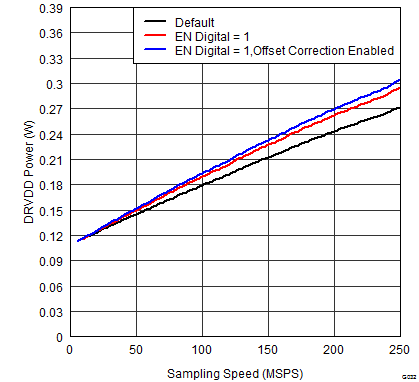 Figure 32. Digital Power vs Sampling Frequency
Figure 32. Digital Power vs Sampling Frequency
8.13.2 Contour
All graphs are at 25°C, AVDD = 1.8 V, DRVDD = 1.8 V, maximum rated sampling frequency, sine wave input clock. 1.5-VPP differential clock amplitude, 50% clock duty cycle, –1-dBFS differential analog input, high-performance mode disabled, 0-dB gain, DDR LVDS output interface, and 32k-point FFT, unless otherwise noted.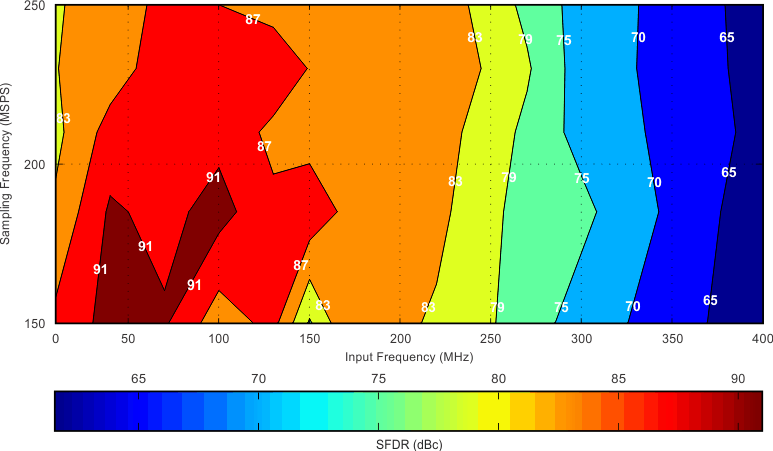 Figure 33. Spurious-Free Dynamic Range (0-dB Gain)
Figure 33. Spurious-Free Dynamic Range (0-dB Gain)
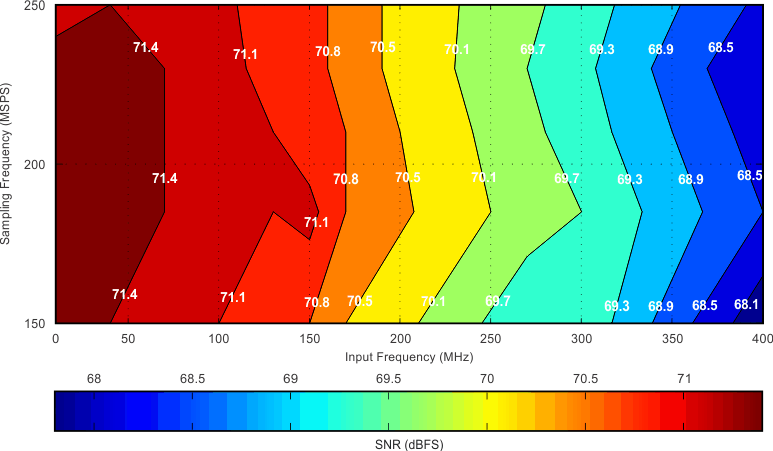 Figure 35. Signal-to-Noise Ratio (0-dB Gain)
Figure 35. Signal-to-Noise Ratio (0-dB Gain)
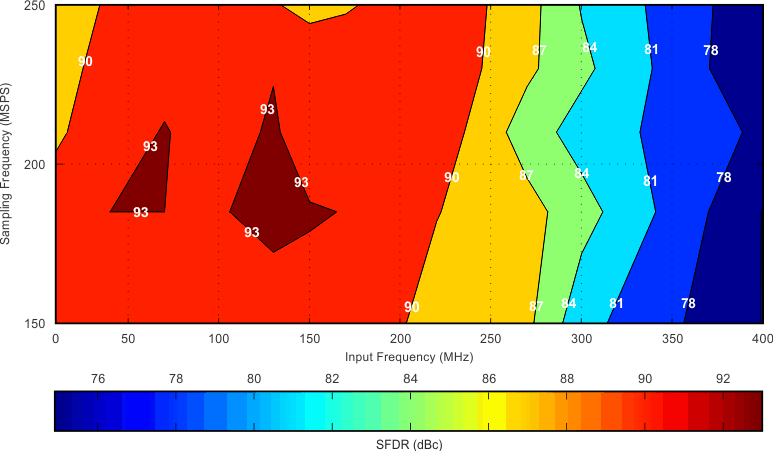 Figure 34. Spurious-Free Dynamic Range (6-dB Gain)
Figure 34. Spurious-Free Dynamic Range (6-dB Gain)
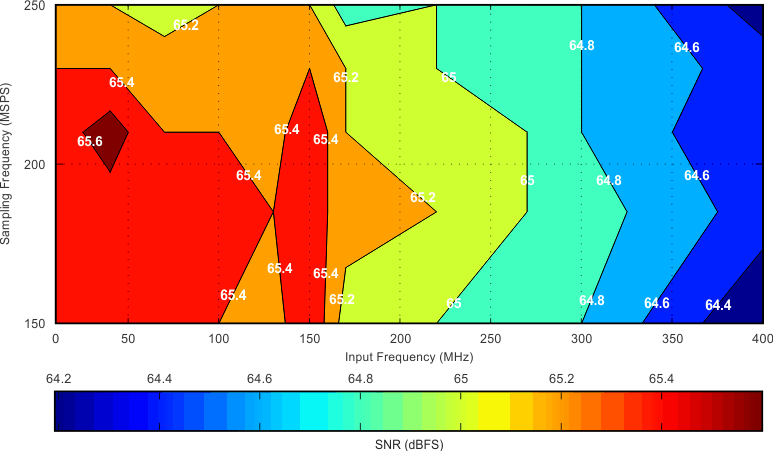 Figure 36. Signal-to-Noise Ratio (6-dB Gain)
Figure 36. Signal-to-Noise Ratio (6-dB Gain)